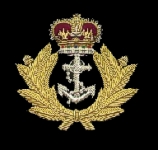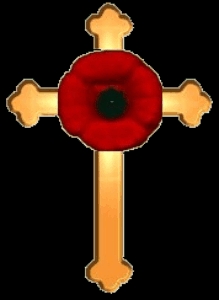|

C/JX 173344
Able Seaman
Milton Albert McGrath

Hometown Branch, St. Mary's Bay, Newfoundland
Royal Navy
H.M.S. Thanet
Died
Age: 33
27th January 1942
Sinking of the HMS Thanet
Loved Ones
Son of Albert and Mary J. McGrath, of Placentia East, Newfoundland
Memorial
65, 1.
Chatham Naval Memorial
(No known grave)
Branch Memorial
http://www.stemnet.nf.ca/monuments/nf/branch.htm
HMS Thanet
The people of the Isle of Thanet Kent, were very generous in providing the money to purchase HMS Thanet during the Government Adopt A Warship week during the second world war. Built in 1919 when the then Mayor of Margate Mr. W Booth-Reeve JP was asked to suggest a suitable crest for ship and he chose a model of the North Foreland Lighthouse, which was readily adopted.
HMS Thanet H29 was a destroyer of the R&S class launched on the 5th November 1918 with a complement of 6 officers and 96 crew. She joined the 4th Destroyer Flotilla and in 1921 was reduced to the reserve. By 1939 Thanet was serving with the Singapore and Hong Kong Local Defense Forces, and by the outbreak of the pacific war against Japan was part of the operational force under the Flag Officer Malaya for the initial Japanese invasion of Malaya in December 1941.
On Christmas day 1941 a Catalina of 205 squadron was shot down by a Japanese GM3. The injured crew took to the water. A Catalina from Singapore was sent out dropping life saving equipment and two dinghy's and a message telling them that HMS Thanet was on is way to pick them up, however before Thanet could arrive, a Dutch submarine took the air men on board. On the 26th January it was reported that a large Japanese Naval force and convoy of ships were heading for a landing at Endau an Estuary at the mouth of the Endau river which was an ideal harbour for such an operation. It was anticipated that the Japanese would make a landing here to regroup for a final attack on Singapore.
Late on the 26th January the Japanese were engaged in landing men from the transports Kansai Maru and Kanberra Maru. escorted by the light cruiser Sendai and destroyers Hatsuyuki and Shirayuki.
HMS Thanet commanded by BS Davies RN and HMAS Vampire commanded by WTA Moran RAN left Singapore Naval Base at 1630 hrs on the 26th heading for the island of Siribuat where there had been reports of an enemy force lay off at anchor. Thanet and Vampire using various alterations in speed and direction to avoid detection headed for Siribuat. After the moon had set at 0200 on the 27th January, and finding no sign of the enemy at Siribuat, both ships made for Endau. Visibility was poor, down to two miles. While approaching Endau Vampire sighted the enemy and discharged three of her torpedoes at the Japanese destroyer Shirayuki and mine sweeper W1 which were both at close range, but without success. It was thought that the torpedoes had not had sufficient time to reach their depth setting so had passed harmlessly below the two ships.
As vampire and Thanet entered Endau all hell was let loose with both ships being illuminated as they zig zagged at full speed under a hail of enemy fire. The intensity of the action on meeting up with the Japanese war ships Shirayuki, Fubuki, Asagiri, Yuguri and several others in the background was indescribable.
Vampire discharged her last torpedo and Thanet her last three, at the same time both ships engaging with their guns. The torpedoes failed, but the high speed attack from Vampire and Thanet continued still in station. At this point the enemy concentrated all their fire power on Thanet and she was hit several times in the engine and boiler room area. The main steam pipe was fractured and caused her to slow down considerably. Suddenly there was a huge explosion and a high burst of steam and smoke as Thanet began to sink. Vampire laid a smoke screen in an attempt to shield her, but Thanet was totally illuminated as she was attacked continually by Fubiki, Asagari, Yugiri and the W1 mine sweeper until she was sunk. There was no opportunity for Vampire to pick up any survivors when two of the enemy destroyers commenced attacking one of the others. At the same time the Japanese cruiser Sendai was closing in on Thanet allowing Vampire to escape without damage or casualties. She arrived back in Singapore later the same day. One enemy destroyer was reported beached, and the troop transports Kansai Maru and Kanbera Maru had been heavily damaged.
As Thanet was sinking in the early hours of that 27th January morning she took with her the members of her crew who had been killed in action. Survivors were making their way to the shore line in boats, Carley rafts, and anything which would float. Several of the Thanet crew had managed to reach shore and were joined by one or two bomber crew. The Japanese ship ‘SHIRAYUKI’ is believed to have picked up one officer, Sub Lieutenant Danger, and 30 ratings. Sub Lieutenant Danger remained on board the ‘Shirayuki’ but the ratings were handed over on the 28th January to the Japanese Army Group Invasion Force which had landed at Endau. It is believed that all of these men were executed.
Sergeant Charles Macdonald, one of the Vilderbeast bomber crew which had crashed commenced his escape, during which time he came across a number of bedraggled sailors from Thanet, and together they made their way through the jungle to Singapore. Another airman Sgt Harry Lockwood who had baled out of an Albacore and injured his back also met up with six members of Thanet crew heading for Singapore. Pilot officers Barclay and Cummings of Aircraft K6337 had ditched north of Mersing, finding a discarded boat they sculled across the Mersing river where they came across a number of Thanet crew. Sleeping during the day and rowing by night until picked up by a 1000 to coaster manned by a British officer and Chinese crew which took them on to Singapore.
In a separate incident a missing Hurricane pilot John Fleming who had ditched into the sea, after which he swam ashore and hid in the swamps. He observed several Japanese soldiers who presumably had been sent to locate him. Hiding in the undergrowth until morning, he then swam across the Mersing river and fell asleep from exhaustion, He awoke to the sound of gunfire and witnessed the naval battle. Later he continued his trek south and came across a dozen or more men of the Thanet two or three severely injured. Close to the shore they found a naval whaler which with Sgt Fleming's assistance they sailed for Singapore, further along the coast they were hailed by a number of others from the Thanet crew and two crew men from the shot down Vilderbeast. Closer to Singapore a British manned Freighter took them all aboard and landed them at Singapore.
Some of these men were sent on to Colombo to join other ships, a number remained in Singapore hospital and were taken prisoners when Singapore surrendered to the Japanese.
Two days previous to the sinking of Thanet, the Japanese imperial guards division had been caught in an ambush set by the Australian and British Brigade in which the Japanese suffered very heavy losses in excess of 700 men in the one battle. This was the Japanese biggest defeat in battle and it is assumed that this loss of face was the nucleus for the Japanese brutal and depraved conduct. Thereafter there was to be no mercy and no prisoners taken. Hundreds of Allied soldiers cut off from their units were slaughtered in cold blood.
On the 27th January the 22nd Indian Brigade had been cut off at Layang, many of the soldiers abandoned their uniform while others made their way back to Singapore. From the 30th January onwards, British and Allied soldiers were retreating across the Johore causeway, while at the same time further units of the 18th division were arriving in Singapore. The Empress of Asia had been sunk off Singapore while the defence of Singapore was being prepared, and on the 15th February 1942 Singapore surrendered to the Japanese
Twenty days after the sinking of the Thanet, Singapore had capitulated, During that last twenty days a number of Thanet crew members managed to make their way to Singapore. But there is no evidence than any of these men survived to the end of the war. in the public records office Kew, there is a signal message from the Flag officer Malaya which states that 65 of the Thanet crew had found their way to Singapore.
The Admiralty nominal list of officers and ratings of the 26 January 1942 gives a figure of 116. But two ratings were listed in the memorial register as having died in March, one aboard the HMS Stronghold and one aboard HMS Sultan.
The Japanese Institute of Defence Studies confirm that 1 Torpedo officer 5 Petty officers and twenty five seamen were taken prisoner by the Japanese destroyer Shirayuki. on the 27th January, and that on the 28th January 30 ratings were handed over to the Japanese army group which had landed at Endau. One officer Sub Lt R H Danger remained aboard the Shirayuki, and was later landed in Indo China where he became a POW.
The following are the confusing lists on record.
Table 1 gives Admiralty list on the 26 Jan 1941 includes six Chinese in the crew of 116
Table 2 taken from Signal officers memo shows 65 survivors.
The memorial register records just 41.
Reported to have died on other ships 2
POW survivor 1
Captured at Endau 30.
Unaccounted for Chinese 6 Total 145.
Table 3 Flag officers signal 65
memorial register 41. includes 30 taken POW at Endau
memorial from other ships 2.
POW survivors 1.
No record of 6 Chinese
Total 109
Research undertaken in 1994 indicates that a Japanese signal was sent to British naval sources confirming that 30 sea men had been taken prisoner of war on the 27th January. On the 28th January this was confirmed stating that all men had become prisoners of war and taken to a POW camp.
Local residents had stated that on the morning of the 28th there had been machine gun fire coming from the position the prisoners were being held. A further report from a local Japanese resident stated emphatically that all prisoners had been executed in retaliation for the hundreds of Japanese soldiers killed in the ambush of the 25th January
HMAS Vampire was later attacked and sunk by Japanese Dive bombers 31st March 42
HMS Sultan also was sunk on the 31st March 1942
HMS Stronghold was sunk by a Japanese cruiser on the 3rd march 1942
Of the Japanese ships
Shirayuki was sunk with three other destroyers and eight transports by Australian and American bombers. April 1942
Yugiri was sunk alongside two other destroyers and troop carriers by American task force 25th NOV 1943
Hatsuyki Sunk by US bombers 17th July 1942
Sendai was sunk by radar controlled gun fire 2nd Nov 1943
Asagiri was sunk by US bombers at Guadalcanal 28th Aug 1942
Amigiri was sunk by a mine West of Borneo 23rd Apr 1942
Subuki was sunk by gunfire from US cruiser 11th Oct 1942.
In 1977 General Deisel Malaysia reported that a diving survey had reported that Thanet lies in 40 feet of water about five miles off the Malay coast. Her guns are elevated at 20 degrees. and surrounded by empty shell cases, and her torpedo tubes are empty.
The ships bell was recovered and presented to the Isle of Thanet and is kept at the old Chatham Port Church.
|